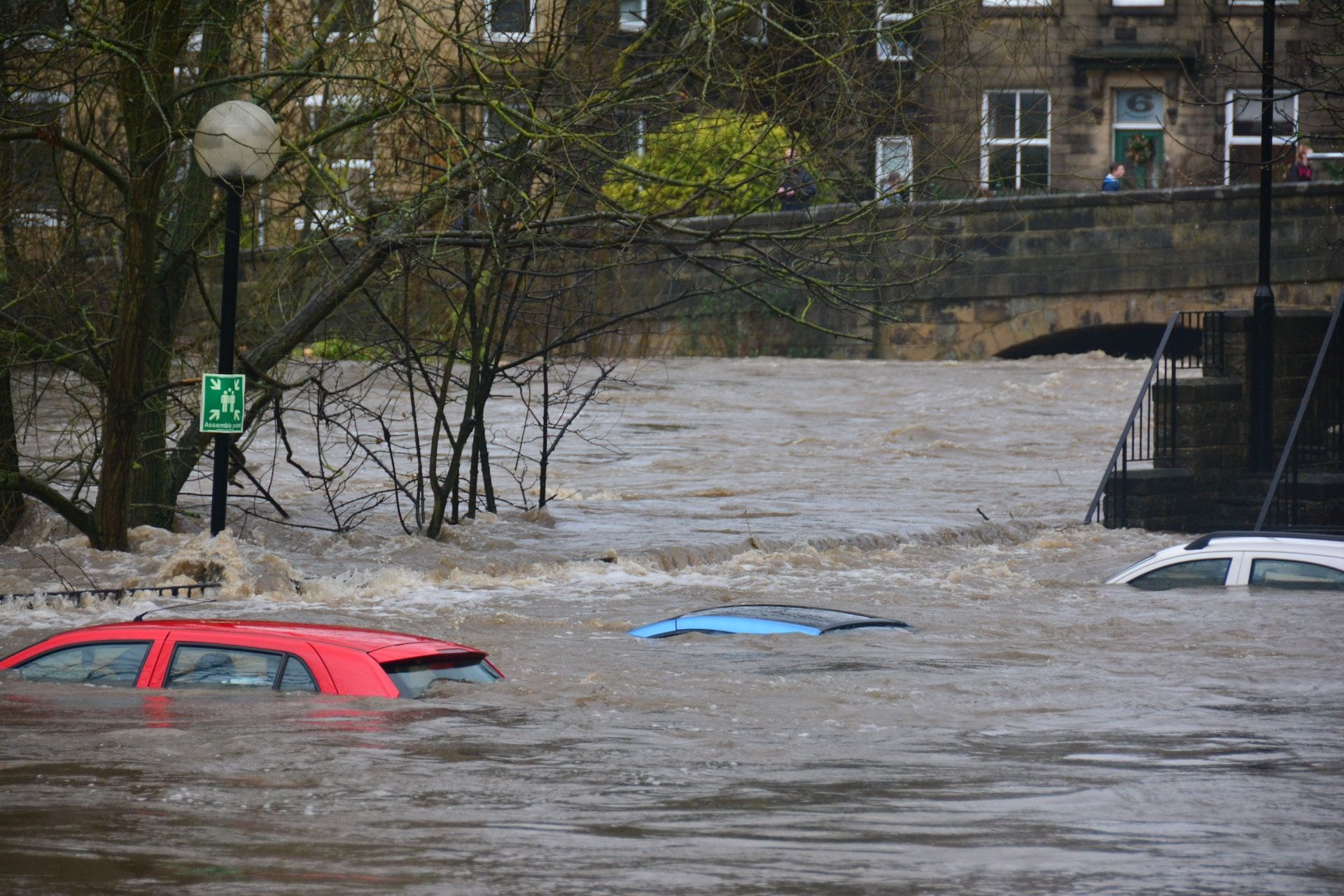Betting against worst-case climate scenarios is risky business
By David Spratt | September 4, 2023
 Illustration by Erik English. Original images from Edge2Edge Media / Unsplash / 1xpert / gizemg / Adobe.
Illustration by Erik English. Original images from Edge2Edge Media / Unsplash / 1xpert / gizemg / Adobe.
Would you live in a building, cross a bridge, or trust a dam wall if there were a 10 percent chance of it collapsing? Or five percent? Or one percent? Of course not! In civil engineering, acceptable probabilities of failure generally range from one-in-10,000 to one-in-10-million.
So why, when it comes to climate action, are policies like carbon budgets accepted when they have success rates of just 50 to 66 percent? That’s hardly better than a coin toss.
Policy-relevant scientific publications, such as those produced by the Intergovernmental Panel on Climate Change, focus on the probabilities—the most likely outcomes. But, according to atmospheric physicist and climatologist Hans Joachim Schellnhuber, “calculating probabilities makes little sense in the most critical instances” because “when the issue is the survival of civilization is at stake, conventional means of analysis may become useless.”
Have scientists and policy makers given too much weight to middle-of-the-road probabilities, instead of plausible-worst possibilities? If so, it’s an appalling gamble with risk. Humanity could end up the loser.
Understanding risk. A key approach to climate “risk” is estimating how much damage will be caused by a climate event, and how likely that event is to occur. These two key factors combine to give the size of the risk in dollar terms by multiplying the probability (likelihood) of an event happening by the monetary damage (impact) caused should it happen. The higher those figures, the greater the risk. Policy makers faced with a number of choices should rationally pick the option with the lowest overall monetary risk.
In everyday life, events may have a relatively high probability—for example, light rainfall—but cause little damage; these are low risk events. But very heavy storms made more intense by climate warming can result in widespread flooding and loss of property and life, and are considered a high risk because the potential damage is so large, even though these storms happen rarely. It is the high-end possibilities that matter most.

Tipping points. One of the big things that make climate projections difficult is non-linear change. Although complex systems like the Earth system and its components generally exist in well-defined stable states, shifts from one stable state to another are often sudden and disruptive, as when huge areas of polar sea-ice disappear in just one season.
Generally, systems are stable in their ability to return to the same equilibrium state after a temporary disturbance, and resilient in their ability to absorb change and disturbance and still maintain the same basic relationships. Ecosystems are a good example. But too big a disturbance, and positive feedback (or amplifying) processes internal to the system may destabilize it. The events that precipitate these non-linear shifts are called tipping points. The change may be abrupt and irreversible on relevant human time frames, and this can start a chain reaction impacting other systems.
For example, a cyclist can maintain stability on a bike, even as it tilts or wobbles to some degree. But one big enough disturbance—a pothole, for example—and stability is lost and the system quickly transitions to a new state, with bike and rider horizontal on the road. Other nearby bikes, such as in a race peloton, may also be affected in a cascade of non-linear changes.
This matters because many large climate systems—polar ice sheets, ecosystems, atmospheric and oceanic circulation—can be stable through a certain amount of warming or cooling, but once a threshold is breached, non-linear change fundamentally alters the system.
Jonathan Donges of the Potsdam Institute for Climate Impact Research says that “to effectively prevent all tipping risks, the global mean temperature increase would need to be limited to no more than one degree – we are currently already at about 1.2°C.”
Faster than forecast. As I previously wrote in the Bulletin, scientific observations and data from around the globe show that many of the changes that scientists thought would occur later this century are already here, ahead of schedule.
Many current changes are at the upper limit of scientific projections, and sometimes beyond them. This year, heat records have been smashed, and global ocean surface temperatures are at the top of the projected range. Other events, including sea-surface warming in the North Atlantic and the eye-watering decline of sea-ice around Antarctica, have simply astounded scientists.
“On the one hand, we knew these things were going to happen. These have been the predictions for a long time,” Claudia Tebaldi, a scientist at the Pacific Northwest National Laboratory, told the Washington Post earlier this year. “[But] this year, in particular, has seemed so extreme.… The size of the anomalies is surprising.”
In 2007, Richard Alley, a paleoclimatologist at Penn State University, said the dramatic loss of Arctic sea ice in the northern summer was “100 years ahead of schedule.” And in 2014, when Eric Rignot, a glaciologist at NASA’s Jet Propulsion Laboratory, wrote that “the retreat of ice in the Amundsen sea sector was unstoppable [and] will likely trigger the collapse of the rest of the West Antarctic ice sheet,” Australian researcher Malte Meinshausen called it “a game changer” and a “tipping point that none of us thought would pass so quickly.”
This year, the Atlantic Meridional Overturning Circulation, or AMOC, has become a flashpoint for debating how to express and explain climate risk. This phenomenon refers to the complex web of ocean currents covering the breadth and length of the Atlantic, from the Southern Ocean to the Arctic, which help regulate global weather patterns. Its collapse, or cessation, would result in much colder weather in parts of Europe by 3 to 6 degrees Celsius (5.4 to 10.8 degrees Fahrenheit), a shifting of the tropical monsoon that billions of people rely upon for food production, and more rapid sea level rises in parts of the United States and Europe.
This system has already slowed by 15 percent since the mid-20th century, and in 2021 researchers concluded there is “strong evidence that the AMOC is indeed approaching a critical, bifurcation-induced transition” (in other words, a tipping point) but the timing was unclear. Then, in July, a study again drew headlines and surprise when it estimated “a collapse of the AMOC to occur around mid-century under the current scenario of future emissions,” with a high confidence (95 percent probability) of it occurring between 2025 and 2095. This finding is contested, but eminent scientists have said it cannot be easily dismissed.
This is starkly different from the Intergovernmental Panel on Climate Change projection that the Atlantic Meridional Overturning Circulation would weaken in the 21st century but “a collapse is very unlikely,” with only a 50/50 chance of collapse by 2300 in a high-emission scenarios.
Stefan Rahmstorf, a professor of physics of the oceans at Potsdam University in Germany, said that while there is still “large uncertainty where the tipping point of the AMOC is… the scientific evidence now is that we can’t even rule out crossing a tipping point already in the next decade or two,” and “the conservative IPCC estimate, based on climate models which are too stable… is in my view outdated now.”
“However, ‘very unlikely’ in IPCC jargon only means less than ten percent,” Rahmstorf added, and “this is only of limited reassurance in the case of a major risk that you want to rule out with a probability of 99.9 percent.”
Facing uncertainty. One of the main policy-making tools for the IPCC’s emissions-reduction analysis and the creation of carbon budgets are climate–energy–economy models known as Integrated Assessment Models. How Integrated Assessment Models deal with risk and uncertainty is a key question because of their political centrality.
While the word “model” suggests some technocratic neutrality, Integrated Assessment Models are in fact social constructs, where “the very structure of a model depends on the modeller’s beliefs about the functioning of society.” They have the power to privilege particular policy pathways and entice policy makers into thinking that the forecasts the models generate and the way they deal with risk have some kind of scientific legitimacy.
But this is not the case. “What they are not, it is important to note, are forecasts or predictions for the future,” says Joeri Rogelj, director of research at the Grantham Institute on Climate Change and the Environment. “Therefore, the scenarios in the IPCC database have no inherent predictive power—and no amount of analysis, selection or staring at spaghetti plots will change that.”
Integrated Assessment Models deal with risk by providing cost-benefit risk analysis of various emission-reduction and energy choice scenarios, and depend on being able to quantify both the damages caused by climate disruption, and the probabilities of such events. But this is a deeply-flawed approach, because damages are essentially unquantifiable, and the likelihoods may be deeply uncertain.

Unquantifiable damages. We do not have realistic measures of the economic costs from future climate damages. Tom Kompas, a professor of environmental economics and biosecurity at the University of Melbourne, says projections for economic damages under different global warming scenarios “are difficult to come by, save for simple, highly aggregated measures drawn from basic computational models… which can often be very misleading given their extreme and implicit tendency to average effects.”
The International Monetary Fund notes a growing agreement between economists and scientists that “risk of catastrophic and irreversible disaster is rising, implying potentially infinite costs of unmitigated climate change, including, in the extreme, human extinction.” And a 2020 report concludes that exceeding climate tipping points “could lead to catastrophic and irreversible impacts that would make quantifying financial damages impossible” (emphasis added).
In other words, we cannot put a dollar figure on how much damage climate disruption will cause at the levels of warming towards which we are now heading. It is a case of “deep uncertainty” which occurs when decision makers and stakeholders do not know or cannot agree on the likelihood of different future scenarios.
Adding to the uncertainty are system climate feedbacks and tipping points. Feedbacks occur when an initial change in a system, for example warming generated by carbon emissions, causes a secondary change which in turn magnifies the initial effect and becomes self-reinforcing. An example is Arctic sea-ice, which is retreating due to the burning of fossil fuels, but as the heat-reflecting white ice is replaced by dark ocean water, more heat is absorbed in this feedback loop.
In a complex system, second-order social impacts including armed conflict, state breakdown, and mass migration are deeply uncertain. Climate change is a “ruin” problem of irreversible harm and a risk of total failure, meaning negative outcomes are economically unquantifiable and may pose an existential threat to human civilization.
Confronting the unknown. Climate models are complex sets of mathematical equations that approximate the real world—in the atmosphere, in the oceans, and on land, and the carbon cycle, including human emissions—as best they can. Climate science is a relatively new field, and as knowledge has accumulated rapidly, models have become more accurate in describing what is likely to happen.
Models assume that all relevant processes can be quantified by way of a mathematical value, formula, or probability. Model projections are generally communicated as a most likely outcome, and a range to incorporate uncertainty; for example: “the projected warming is 2.4°C with a range of 1.6-3.2°C (95% probability).”
Models are good at linear processes, and have been right on-the-money at projecting future temperatures based on increasing emissions, for example. There is also a straightforward relationship between warming and how much moisture the air can carry: an extra seven percent for each 1 degree Celsius rise and thus the capacity for more intense rainfall events. Warmer seas can also generate stronger cyclones.
But assigning probabilities to non-linear or sudden-change events and tipping points is very difficult.
The problem is not about a lack of knowledge that the system will change if it gets hot enough, but when. Current climate models are not capturing all the risks, and William Ripple and his co-researchers show that many positive feedbacks are not fully accounted for in models. This deficiency covers the cryosphere (the frozen parts of the Earth, like glaciers and sea ice) and changes in some oceans and atmospheric circulatory systems—including in the Southern Ocean, the Atlantic Meridional Overturning Circulation, the Arctic Jet Stream, and the Greenland and Antarctic ice sheets.
If the damages are deeply uncertain, and non-linearity restricts the ability to assign probabilities to future events, then the dependence on Integrated Assessment Models to provide action choices is a very bad policy-making choice.
Reassessing risk management. When the very foundation of modern human societies and the complex and fragile, globalized network within which they co-exist are threatened, the normal approach to risk management is not appropriate given current model deficiencies, the largely unquantifiable nature of climate damages, and the deep uncertainties.
Yet a key feature of Intergovernmental Panel on Climate Change reports on the physical science has been the elevation of climate models to the center of the process, relegating to a secondary position the bigger picture understandings that come from climate history (paleoclimatology). Paleoclimatology teaches that in the long run each one degree of warming will raise the oceans by 10 to 20 meters, or roughly about 30 to 65 feet. Models, unable to properly include cryosphere processes, suggest sea-rises by the year 2100 to be so small that the projections are not credible, a process of scientific reticence highlighted by NASA science chief James Hansen as far back as 2007.
In such circumstances, how can scientists and policy makers deal with the questions of risk and deep uncertainty?
Firstly, they should recognize the limitations of both Earth system and climate-economy models and not assign them an exalted position for which they are ill-suited. Other forms of knowledge drawn from past climate history should be given more weight, as should expert opinion. Asking a group of climate experts what they think is likely to happen given their knowledge and experience will produce a more frank picture than those drawn strictly from peer-reviewed literature where conclusions must be “beyond reasonable doubt.”
Secondly, they should recognize that the high-end possibilities have by far the greatest overall risks, and they should receive special attention. Because climate change represents an existential risk to human society, particular focus must be given to one question above all others: “What is the plausible worst-case scenario and what do we have to do to avoid it?”
Writing about the “climate endgame,” Luke Kemp from Cambridge’s Centre for the Study of Existential Risk and his colleagues agree that “prudent risk management requires consideration of the bad-to-worst-case scenarios” because low-probability, high-impact extreme outcomes have damages so large as to perhaps be unquantifiable. They say that large uncertainties about dangerous surprises “are reasons to prioritize rather than neglect them.”
But this is what the Intergovernmental Panel on Climate Change and climate research and risk managers in the financial system have overwhelmingly not done. New analysis shows that the potential to end humanity is “dangerously underexplored” by the Intergovernmental Panel on Climate Change, with textual analysis finding that their assessments have shifted away from high-end warming to increasingly focus on lower temperature rises, even as “global heating could become ‘catastrophic’ for humanity if temperature rises are worse than many predict or cause cascades of events we have yet to consider, or indeed both” as noted by a paper published in the journal Proceedings of the National Academy of Sciences. “We know least about the scenarios that matter most,” Kemp says.
Policy makers and global leaders seem not to recognize that when risks are existential, a bad outcome means the future is unrecognizably different from before. By downplaying the high-risk possibilities, the Intergovernmental Panel on Climate Change and others are foolishly conducting a dangerously unprecedented experiment: how much heat—how much change—can human systems tolerate before society collapses?
Correction: An earlier version of this story misspelled Stefan Rahmstorf’s name as Rahmsdorf.
Together, we make the world safer.
The Bulletin elevates expert voices above the noise. But as an independent nonprofit organization, our operations depend on the support of readers like you. Help us continue to deliver quality journalism that holds leaders accountable. Your support of our work at any level is important. In return, we promise our coverage will be understandable, influential, vigilant, solution-oriented, and fair-minded. Together we can make a difference.
Keywords: IPCC, climate risk, existential risks, existential threats, ipcc report, tipping point, tipping points
Topics: Climate Change
















Dear Dr. Spratt: Thank you for this interesting article. You have done a good job identifying a serious problem. I am, however, left to wonder what a policy maker should do about it. As the old saw goes, “politics is the art of the possible,” and given that policy makers and the societies that they represent are unable to reach even the more modest carbon reduction goals, it is hard to imagine how more robust action would be possible. Also, although I take your point about peer reviewed literature tending to err on the side of caution, I fear that… Read more »